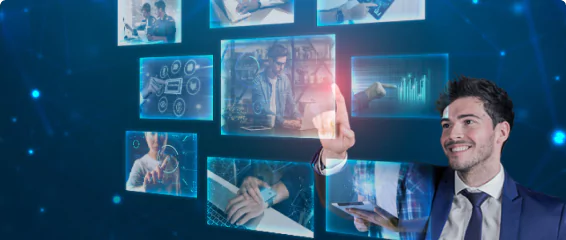Machine Learning and AI for revolution of Tech Companies are changing and streamlining businesses.
These days, when AI has taken all industries by storm, from small startups to big tech giants, entrepreneurs are talking about artificial intelligence and automation. In a recent interview, Satya Nadella said that SaaS is going to be replaced by AI agents. We are believers in his statement, but partially, as we think SaaS is not going to die anytime soon.
We are one of the top-rated SaaS product engineering companies, and we have first-hand experience with many businesses from various industries that are still investing in making their SaaS product intelligent with AI and automation.
The significance of SaaS product engineering has grown exponentially, with Gartner predicting worldwide spending on public cloud services to reach $723 billion in 2025. This growth shows how SaaS has become the dominant model in cloud computing, transforming how businesses access and utilize software solutions.
For businesses, working with a specialized SaaS product development company provides numerous advantages, including reduced infrastructure costs, faster deployment, easier scalability, and continuous updates without disruption to end-users. The ability to access applications from anywhere with an internet connection has made SaaS solutions particularly attractive in our increasingly remote work environment.
What Are the Key Characteristics of Saas That Influence Product Engineering?
Understanding the core characteristics of SaaS is crucial for effective SaaS product engineering. These traits shape architectural decisions, development processes, and operational strategies.
Key characteristics include:
- Cloud-based: Most SaaS products leverage versatile cloud services for data management, offering benefits like flexible data storage, real-time analytics, and enhanced data access.
- Multitenancy: Often, multiple users (tenants) share the same application instance while their data and configurations remain isolated, enabling efficient resource management and cost-effectiveness. Multi-tenant architecture is a key consideration in SaaS software development.
- Scalability: SaaS products must easily scale to handle increasing users and requests without performance issues. Scalability influences architectural choices and the technology stack for cost-effective development. SaaS product engineering focuses on building products with scalability in mind.
- Subscription-based model: Customers typically pay a recurring fee for access, which creates continuous value through regular revenue streams. This impacts how the product evolves and is supported.
- Accessibility: SaaS is usually accessed via web browsers, making it highly appealing as users don’t need to install or maintain software locally. This mobile access is especially convenient.
- Service-Level Agreements (SLAs): Providers guarantee a specific level of service to clients, requiring solid infrastructure and data monitoring capabilities to meet strict SLA requirements.
- Security and Compliance: High security and compliance standards are necessary to protect sensitive data and ensure regulatory adherence. The provider typically maintains cybersecurity, which is an advantage of the model. Security is a major focus in SaaS application development services.
- Continuous Evolution: SaaS is designed for constant evolution, adapting to changing client needs through seamless feature integration, dynamic support, and cost-efficient storage. This aligns with iterative development practices.
Read: End-to-End AI Product Engineering in Real Estate: From Concept to Completion
Accelerate Your SaaS Product Engineering Journey
Partner with ViitorCloud to develop scalable and innovative SaaS solutions tailored to your business needs.
What Are the Essential Stages in the SaaS Product Engineering Lifecycle?
Building a SaaS product is different from traditional software development and involves a unique lifecycle.
At ViitorCloud, we follow these steps for SaaS product engineering:
Step #1: Ideation and Planning
This initial phase involves brainstorming, validating ideas against market needs, target audience, competitive landscape, and customer needs. It includes market analysis, identifying business opportunities, defining strategies, assessing cloud architecture, and engaging stakeholders. Gathering feedback from potential users is critical.
Step #2: Requirements Gathering
Outline the specific requirements for the SaaS product, including features, multi-tenancy architecture, self-service capabilities, security measures, and user activity monitoring.
Step #3: UI/UX Design
Focus on user-centric design principles to create an intuitive and delightful user experience. User experience and architecture should align with business goals and audience needs.
Step #4: Subscription/Selection Stage
This stage involves critical decisions like choosing a cloud provider (e.g., AWS, Google Cloud, Azure) based on factors like scalability, accessibility, cost, and support. It also includes determining the delivery or subscription model (e.g., freemium, per-user, tiered) and building the development team, whether in-house, remote, or outsourced.
Step #5: Development and Testing
This phase involves coding, building the application, and rigorous testing (automated and manual) to ensure quality and stability. Choosing the right tech stack (frontend and backend frameworks) is crucial and impacts the product even after launch. Considering microservices architecture can improve scalability and flexibility.
Step #6: Deployment
Releasing the developed application to the cloud infrastructure.
Step #7: Operations and Maintenance
After launch, continuous monitoring, performance tracking, reliability checks, updates, and ongoing maintenance are essential to keep the product running smoothly and evolving. Implementing robust monitoring and analytics systems is wise before release.
Also Read: The Role of Digital Product Engineering in Logistics Innovation
What Are the Important Best Practices for Effective Saas Product Engineering?
Following best practices is like searching for a “press to win” button in the competitive SaaS market. Adhering to these practices can make all the difference.
- Feature Prioritization: Start by identifying core features for an early version, building a Minimum Viable Product (MVP) to test the market and get feedback.
- Product Roadmapping: Define a clear roadmap outlining milestones and goals for the product’s evolution over time, keeping the team focused while staying responsive to market changes.
- Iterative Development: Release the product gradually and incorporate user feedback, ensuring new features add value and meet evolving needs. This allows for more effective adaptation to feedback and market changes.
- Sustainable Architecture: Select an architecture and infrastructure strategy that fits scalability, flexibility, and maintainability requirements without inflating costs. Key practices include building a sustainable architecture that accommodates business needs and growth goals.
- Enable Customization and Self-Service: Allow end-users to tailor their experience, such as personalizing dashboards, and provide self-service features like account management to reduce reliance on customer support.
- Focus on Security and Compliance: Adhere to high security and compliance standards throughout development.
- User-Centered Design: Develop intuitive, user-centered designs.
- Agile Methodologies: Adhering to agile methodologies is a key best practice.
- Effective Engineering and Deployment: Implement effective engineering and deployment practices.
- Performance Monitoring: Implement robust monitoring and analytics to track performance, uptime, response times, and other critical metrics. Establish standards, track usage, perform load testing, and use real-time alerts.
Check: How End-to-End AI Product Engineering Is Revolutionizing Time-to-Market Strategies
Transform Your Ideas into Market-Ready SaaS Solutions
Leverage our expertise in product engineering to bring your SaaS vision to life efficiently and effectively.
Important Technical Considerations in Saas Product Engineering
Technical decisions profoundly impact the success and sustainability of a SaaS product.
SaaS Architecture
Choosing the optimal architecture is critical. Options include single-tenant (isolated application and data for each user) or multi-tenant (shared application instance with isolated data). Multi-tenant architecture is complex but scalable. A cloud microservices architecture is often selected based on resource and data isolation needs.
Cloud Provider
The choice of cloud provider determines where the SaaS product is hosted and influences discoverability, scalability, accessibility, and cost-effectiveness. Major providers include AWS, Google Cloud, and Azure.
API Integration vs. Custom Backend
Decide whether to build custom backend functionalities or use third-party APIs for standard features like payment systems or marketing automation. APIs allow different apps to communicate and can impact costs.
Scalability
The architecture must support easy and cost-effective scaling to handle growth. Scalable development resources are needed to meet SaaS goals.
Technology Stack
Selecting the right frontend and backend frameworks is vital for development solutions and required features. The choice should be future-proof and have sufficient community support.
Also Check: How Digital Product Engineering in Healthcare Is Driving Transformation
Enhance Your Business with Expert Product Engineering Solutions
Discover how ViitorCloud’s SaaS product engineering services can drive your business success.
ViitorCloud Can Be Your Right Partner for SaaS Product Engineering
For businesses seeking to develop a high-quality, scalable SaaS product while managing costs and time-to-market, partnering with an experienced SaaS product development company like ViitorCloud is a strategic move.
We deliver exceptional SaaS product engineering solutions that empower businesses across multiple industries to innovate and address real problems effectively.
For Logistics, our AI-powered solutions automate manual warehouse tasks, optimize supply chains, and enhance operational efficiency, leading to significant cost savings.
In Healthcare, ViitorCloud drives digital transformation with telemedicine platforms, AI-powered diagnostic tools, blockchain-based EHR systems, and IoT-enabled remote monitoring solutions that improve patient care and operational efficiency.
For Technology companies, our digital product engineering services help create innovative solutions with expertise in generative AI, AR/VR integration, blockchain solutions, and cloud services.
In the Finance sector, we deliver secure, compliant SaaS solutions that streamline operations and enhance customer experiences through cutting-edge technologies.
With over 14 years of experience, a talented team of engineers with 5+ years average experience, and hundreds of successful projects completed, we transform businesses through expert SaaS product development services. Contact us now for a complimentary consultation and get an audit report.









